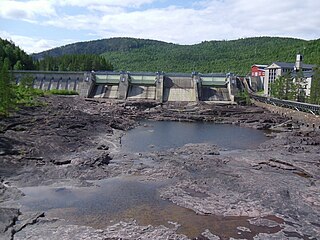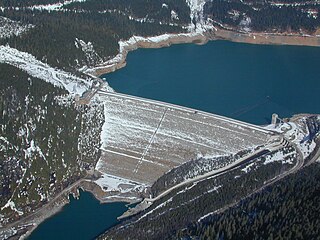
Hydroelectricity is electricity produced from hydropower. In 2015, hydropower generated 16.6% of the world's total electricity and 70% of all renewable electricity, and was expected to increase about 3.1% each year for the next 25 years.

The Nurek Dam is an Earth-fill embankment dam on the Vakhsh River in Tajikistan. Its primary purpose is hydroelectric power generation and its power station has an installed capacity of 3,015 MW. Construction of the dam began in 1961 and the power station's first generator was commissioned in 1972. The last generator was commissioned in 1979 and the entire project was completed in 1980 when Tajikistan was still a republic within the Soviet Union, becoming the tallest dam in the world at the time. At 300 m (984 ft), it is currently the second tallest man-made dam in the world, after being surpassed by Jinping-I Dam in 2013. The Rogun Dam, also along the Vakhsh in Tajikistan, may exceed it in size when completed.

The Tokuyama Dam is an embankment dam near Ibigawa, Ibi District, Gifu Prefecture in Japan. The dam was completed in 2008 and will support a 153 MW hydroelectric power station that is expected to be fully operational in 2015. Currently, Unit 1 at 23 MW was commissioned in May 2014. The dam was originally intended to withhold the upper reservoir of a 400 MW pumped-storage power station until a design change in 2004. The dam is also intended for flood control and water supply. It is the largest dam by structural volume in Japan and withholds the country's largest reservoir by volume as well.

Nuozhadu Dam is an embankment dam on the Lancang (Mekong) River in Yunnan Province, southwest China. The dam is 261.5 m (858 ft) tall, and creates a reservoir with a normal capacity of 21,749,000,000 m3 (17,632,000 acre⋅ft) at a level of 812 m (2,664 ft) asl. The purpose of the dam is hydroelectric power production along with flood control and navigation. The dam supports a power station with nine generators, each with generating capacity of 650 MW. The total generating capacity of the power station is 5,850 MW. Construction on the project began in 2004; the dam's first generator went online 6 September 2012 and the last generator was commissioned in June 2014. The construction and management of the project was implemented by Huaneng Power International Ltd., which has a concession to build, own and operate hydroelectric dams on China's stretch of the Mekong River.

The Ertan Dam is an arch dam on the Yalong River, a tributary of the Yangtze River in Sichuan Province, southwest China.

The Mingachevir Dam is the largest hydroelectric power station in the South Caucasus, is located over Kur river and not far from Mingachevir city.

The Kannagawa Hydropower Plant (神流川発電所) is an under construction pumped-storage hydroelectric power plant near Minamiaiki in Nagano Prefecture and Ueno in Gunma Prefecture, Japan. The power plant utilizes the Minamiaiki River along with an upper and lower reservoir created by two dams, the upper Minamiaiki Dam and the lower Ueno Dam. The power station in between the two dams will contain six 470 megawatts (630,000 hp) pump-generators for a total installed capacity of 2,820 megawatts (3,780,000 hp). Unit 1 commenced commercial operation in 2005 and Unit 2 in 2012. When completed, the plant will have the second-largest pumped-storage power capacity in the world.

The Longyangxia Dam is a concrete arch-gravity dam at the entrance of the Longyangxia canyon on the Yellow River in Gonghe County, Qinghai Province, China. The dam is 178 metres (584 ft) tall and was built for the purposes of hydroelectric power generation, irrigation, ice control and flood control. The dam supports a 1,280 MW power station with 4 x 320 MW generators that can operate at a maximum capacity of 1400 MW. Controlling ice, the dam controls downstream releases to reservoirs lower in the river, allowing them to generate more power instead of mitigating ice. Water in the dam's 24.7 billion m3 reservoir provides irrigation water for up to 1,000,000 hectares of land.

The Yantan Dam is a gravity dam on the Hongshui River near Dahua County, Guangxi China. The main purpose of the dam is hydroelectric power production and it has an associated 1,210 MW power station consisting of 4 x 302.5 MW Francis turbine-generators.

The Votkinsk Hydroelectric Station is a dam and hydroelectric power station on the Kama River along the border of Perm Krai and Udmurtia, Russia. It is 30 km (19 mi) south of Votkinsk and its main purpose is power generation and navigation. The power station has a 1,020 MW installed capacity and the dam also supports a ship lift. Construction on the dam began in 1955, the first generator was operational in 1961 and the last in 1963. The entire project was complete in 1965.

The Okutadami Dam (奥只見ダム) is a concrete gravity dam on the Tadami River, 26 km (16 mi) east of Uonuma on the border of Niigata and Fukushima Prefectures, Japan. The primary purpose of the dam is hydroelectric power generation and it supports a 560 MW power station which is the largest conventional hydroelectric power station in Japan. The dam also forms the second largest reservoir in Japan, next to that of the Tokuyama Dam.

Geehi Dam is a major ungated rockfill embankment dam with an uncontrolled morning glory spillway spillway across the Geehi River in the Snowy Mountains of New South Wales, Australia. The dam's main purpose is for the generation of hydro-power and is one of the sixteen major dams that comprise the Snowy Mountains Scheme, a vast hydroelectricity and irrigation complex constructed in south-east Australia between 1949 and 1974 and now run by Snowy Hydro.

The Bowatenna Dam is a 100 ft (30 m) high gravity dam at Bowatenna, in the Central Province of Sri Lanka. The dam was built in June 1981, and is used primarily for irrigation. A 40 MW power station is also constructed 5,800 ft (1,800 m) downstream, for hydroelectric power generation.

The Kukule Ganga Dam is a 110 m (360 ft) gravity dam built across the Kukule River in the Sabaragamuwa Province of Sri Lanka. The run-of-river-type dam feeds an underground hydroelectric power station located approximately 5 kilometres (3.1 mi) away, via tunnel.

Ghatghar Dam refers to two associated gravity dams built using roller-compacted concrete, the first use in India. They are situated in Ghatghar village in Ahmednagar district Maharashtra, India. Both dams create a lower and upper reservoir for the 250 MW pumped-storage hydroelectric power station. The upper Ghatghar dam is 15 m (49 ft) tall and on the Pravara River, a tributary of Godavari river. The lower Ghatghar dam is 86 m (282 ft) tall and located on the Shahi Nalla which is a tributary of Ulhas River to the south west of the upper reservoir in a steep valley. The hydro power project diverts Godavari river basin water outside the basin area to a west flowing river of Western ghats.

The Hanabanilla Dam is an embankment dam on the Hanabanilla River near the village of El Salto del Hanabanilla in Villa Clara Province, Cuba. The purpose of the dam is to provide water for irrigation and municipal uses and to generate hydroelectric power.

The Claytor Dam is a gravity dam on the New River in Pulaski County, Virginia, United States. It is also located about 2.5 mi (4.0 km) south of Radford. It is named after William Graham Claytor, then vice president of Appalachian Power Company (APC), who was instrumental in the dam's construction. APC is now a subsidiary of American Electric Power (AEP) who owns the dam. The primary purpose of the dam is hydroelectric power generation and it supports a 75 MW power station. Its reservoir, Claytor Lake, is also used for recreation. The dam was constructed and its power station commissioned in 1939. It received its first license in 1943. It is 1,142 ft (348 m) long and 145 ft (44 m) tall. It stores a reservoir with a capacity of 225,000 acre⋅ft (278,000,000 m3). The reservoir covers 4,472 acres (1,810 ha) and stretches 21.67 mi (34.87 km) behind the dam.

Krångede Hydroelectric Power Station is a run-of-the-river hydroelectric power plant on the Indalsälven in Jämtland County, Sweden. About 15 km downstream of Krångede is the urban area Hammarstrand.

Höljes Hydroelectric Power Station is a hydroelectric power plant on the Klarälven in Torsby Municipality, Värmland County, Sweden.






















